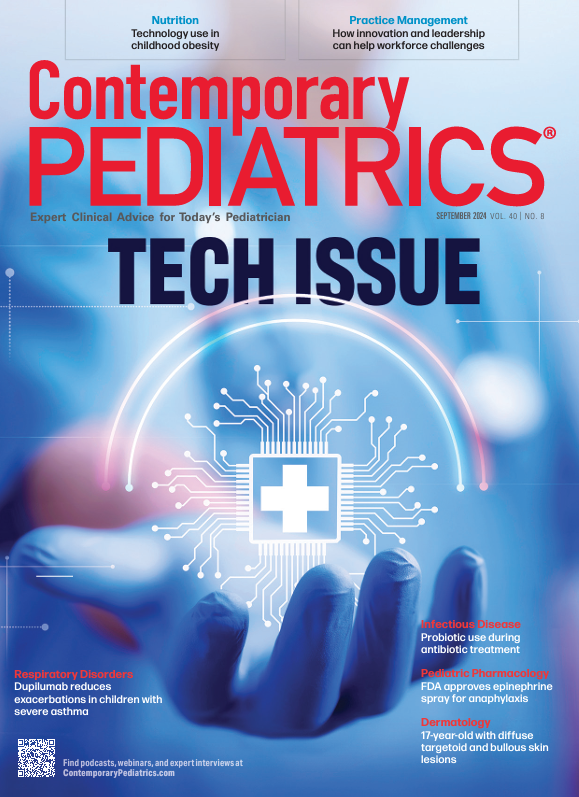Probiotics: Beneficial to pediatric population during antibiotic treatment?
A secondary analysis of a randomized trial points to limited benefits on the microbiota.
Probiotics: Beneficial to pediatric population during antibiotic treatment? | Image Credit: © Mariya - © Mariya - stock.adobe.com.

Fostering healthy microbiota in the gut has been an emerging and significant subject of study within the gastrointestinal specialty. One area that is being studied if taking probiotics would cultivate healthier microbiota.
For the uninitiated, probiotics can include supplements and food products and often include the lactic acid bacteria.1 Gram-positive microbes that have been used for centuries in food production processes and include items such as yogurt, cheese, and pickles.1 Other probiotic sources include kefir, sauerkraut, kimchi, and tempeh, kombucha, and others. Additionally, probiotics can be considered as prophylaxis for antibiotic-associated diarrhea, which in more serious cases, can develop into Clostridioides difficile infection (CDI).
A new study points to the limited effect on children taking probiotics on their microbiota during antibiotic treatment.
Study Specifics and Takeaways
Participants in the study were randomly assigned to either receive a daily placebo or a multispecies probiotic formulation consisting of 8 strains from 5 different genera during antibiotic treatment and for 7 days post-treatment.2
From the original randomized clinical trial, 88 (44 in the probiotic group and 44 in the placebo group were adherent to the study protocol regarding collection of at least 2 stool samples with enough reads between February 2018 and May 31, 2021, the investigators wrote. They collected fecal stool samples at inclusion, the last day of antibiotic use, the last day of the study, and 1 month after treatment. Microbiota analysis of the 4 samples was performed by 16S ribosomal RNA gene sequencing.2
They also report that race and ethnicity data were not collected, and that a limited number of children in each group (13 in the placebo group, and 7 in the probiotic group) had diarrhea, with 10 in the placebo group and 6 in the probiotic group with antibiotic-associated diarrhea (AAD).2
“Alpha diversity did not significantly differ between groups at the first 3 times,” the investigators wrote. “Shannon diversity (mean [SD], 3.56 [0.75] vs 3.09 [1.00]; P = .02) and inverse Simpson diversity (mean [SD], 3.75 [95% CI, 1.66-5.82] vs −1.31 [95% CI, −3.17 to 0.53]; P = 1 × 10−4) indices were higher in the placebo group compared with the probiotic group 1 month after intervention. Beta diversity was not significantly different at any of the times.”2
Additionally, they noted 3 of the 5 supplemented genera were higher during the supplementation, but only had a transient effect as the difference disappeared after 1 month.2
Gut Microbiota as it Relates to C difficile
CDI is another area that is being explored in how it relates to microbiota. Live biotherapeutic products (LBP) are a newer treatment modality for the infection and investigators have been looking at how it affects patient’s microbiota post-treatment. One such therapy is Ferring’s fecal microbiota, notably live-jslm (RBL) LBP. It was the first FDA-approved, single-dose treatment for preventing recurrent C difficile infections (rCDIs) in adults with post standard antibiotic therapy.
In a recent data released by Ferring, investigators in the PUNCH CD3 trial looked at participants who received RBL and successfully avoided CDI recurrence at the 8-week mark. These patients experienced an improvement in their gut microbiota composition and diversity within just 1 week post administration. A median of 10 species (ranging from 0 to 78) had been transferred from RBL to the participants through clonal engraftment. Stool samples collected from participants at various intervals underwent deep shotgun sequencing, revealing insights into microbiome composition and engraftment dynamics.3
In a recent interview with Contagion, Ken Blount, PhD, vice president of Microbiome Research, Ferring said, “Our approach to engraftment analysis began by comparing the gut microbiome of trial participants post-RBL administration with the species present in the RBL dose they received. If sufficient variant loci shared identical sequences between the participant and the RBL dose, it indicated that the species in the participant originated from or engrafted from the RBL dose. This method, aligned with traditional medical understanding of stem-cell engraftment, aims to precisely elucidate how RBL influences the microbiome. We believe this approach provides a clearer definition of engraftment in the context of microbiota-based therapeutics and establishes a leading method for assessing engraftment in rCDI patients."3
Future Studies
The investigators who performed the analysis in the pediatric population offered some insights on the potential direction of the research and where it could be helpful. “Future studies with adequate baseline samples and homogenous study populations that also focus on the function of the microbiota and the association between the microbiota and clinical outcomes are needed to assess whether observed transient effects on taxonomic composition and effects on diversity have a mechanistic role in protection against antibiotic-induced adverse effects, including AAD,” the investigators wrote.2
This article was initially published by our sister publication, Contagion.
References:
1. Behnsen J, Deriu E, Sassone-Corsi M, Raffatellu M. Probiotics: properties, examples, and specific applications. Cold Spring Harb Perspect Med. 2013;3(3):a010074. Published 2013 Mar 1. doi:10.1101/cshperspect.a010074
2. Dierikx TH, Malinowska AM, Łukasik J, et al. Probiotics and Antibiotic-Induced Microbial Aberrations in Children: A Secondary Analysis of a Randomized Clinical Trial. JAMA Netw Open. 2024;7(7):e2418129. doi:10.1001/jamanetworkopen.2024.18129
3. Abene S. Impact of Live Biotherapeutic Products on Gut Microbiome in Recurrent C difficile Infections.
https://www.contagionlive.com/view/unveiling-the-impact-of-live-biotherapeutic-products-on-gut-microbiome-in-recurrent-c-difficile-infections
